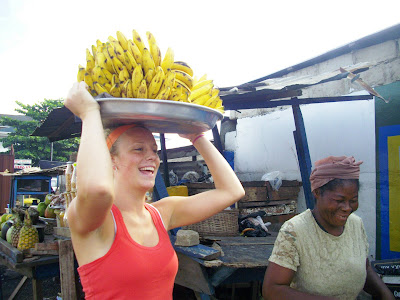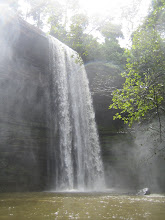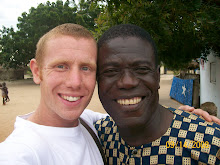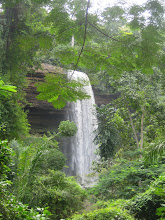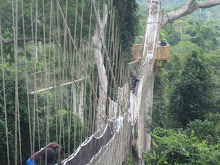




A few weekends ago I went with two Fulbrighters to the Eastern Region to Krobo-Odumase. Each year this village, and many of the other neighboring villages in the area hold a festival for adolescent girls called Dipo Festival. Dipo is a puberty rite festival and signifies a girl’s transition from childhood to womanhood. From what I understand the ceremony actually starts on a Friday and ends on a Monday, but I was only able to see the events of Saturday and Sunday.
I got up early on Saturday morning and caught a trotro to the village and was there by 7am. There were nearly 50 girls that participated in the ceremony this year and when I arrived most of them were in the village center wrapped in traditional cloth waiting for the days’ ceremony to begin. Apparently the day before, they all had part of their head shaved, leaving only a large circle of hair on the top of their heads; the sides and back had been shaved. The priest came and talked to the girls and they were all given a calabash bowl (traditional) with soap, a towel, and a piece of red cloth. They all lined up with the calabash on their heads, from shortest to tallest and marched “down to the river”. I was told that I could not go with them to this part of the ceremony and it is probably better as they were going to bathe. They came back with the red cloth around their waist, symbolizing the fertility of the girl/woman. That was all for Saturday. The girls were to go home and prepare for the next day, which would be a little more intense, especially for me.
The ceremony is traditionally for girls that are roughly 12-16 years old; puberty age, and signifies that they are now women and can marry. However, because it is relatively expensive for a family to send a girl through the ceremony, many families will send all of their daughters through at the same time, regardless of age, because it is less expensive per girl. This year the youngest girl was only 4 or 5 years old and the oldest was 22.
On Sunday, the ceremony did not begin until 1 or 2 in the afternoon. When I arrived, the girls were again in traditional cloth and were dancing as the mothers and aunts drummed and drank gin (sometimes I was not sure if this ceremony was more for the girls or more for the mothers and aunts). After nearly an hour of dancing and drumming, all of the girls were served what looked to me to be banku with palm oil (a large glutinous ball with red oil poured over it). After they had all eaten they got in a circle and stripped down naked. At this point I felt a little bit uncomfortable and looked around to see that there were no other males in the area besides the village elders and little children. I asked Gifty, a lady who had been explaining to me some of the finer points of the festival, if I should go and she not only told me that I should stay but began pointing at certain girls that I should look at who were a bit embarrassed to be naked. I felt uncomfortable.
Fortunately, the mothers and aunts made a circle around the girls and put white cloth around their waist and then began to put strings of beads around their waists. Instead of wearing two or three strands of beads, the girls were wearing hundreds—some of the younger girls were crying because the beads were so heavy. After nearly an hour of dressing the girls, they all lined up, shortest to tallest and began to march through the village with all of the women walking with them.
They walked for about 30 minutes through the village and then the jungle. At one point Gifty told me that when they return they will be carried by a man. She asked me jokingly (or at least I thought) if I would like to carry one of the girls; “Sure” I responded. After awhile Gifty told me that I and the other men could go no further as the girls were approaching the “sacred stone.” From what I could gather, the girls, one by one, approach a traditional fetish shrine, where a priest directs them to sit on the “sacred stone” three times. If they are not a virgin, they will not be able to sit on the stone. When they are finished, they leave, find the man that is to carry them, hop on his back and together, they are off, back to the village. I watched and cheered on the first 10 or 12 girls that came out and were carried past. Then, in a blur, Gifty yelled that I should bend down so that the little girl coming would get on my back. I did as I was told, but actually laughed and continued to think that this was all a joke, I started to walk and was sure that they would stop me after 10 or 15 steps…20 or 30 steps…40 or 50 steps. Nope. I soon realized that they were serious and I would be carrying this girl all the way back to the village. As soon as this realization began to sink in, I looked around to notice that the other men were running with the girls. I began to run and as I did the girl on my back began to bounce up and down, each time strangling me with the arm that was around my neck. I kept running and as I turned a bend, I saw in front of me a stream that I would have to run through. I did, and my shoes were soaked and squishing and squeaking with every step.
For the next 10 minutes of my life I was running through the jungle with a three-quarter naked African girl on my back, wearing 40 pounds of waist beads, strangling me with one arm as she was trying to hold a piece of cloth on her head with the other hand, and a leaf in her mouth so that she could not talk. After we got out of the jungle, we still had to run through the village to the main square. Little did I know that this was a huge cultural event and all the townspeople had turned-out to line the streets to cheer everyone on. Each time I turned onto a new street the crowd went crazy and yelled “brofono” (“white man” in Krobo, the local language) and many people ran alongside for a minute. One woman ran alongside yelling things to me in Krobo which I could not understand at all. Eventually, she said the word “wife.” I had no idea what she meant, but I would soon find out.
When we finally arrived back at the town square, I set the girl down and turned to look at her for the first time—her eyes were as big as watermelons either out of excitement, or fear, or a little of both. Before I could say anything to the girl, the mothers and aunts started to dance around me and sing. I danced with them for a minute and then they told me that the little 9 year old girl that I had just carried, name Nakwua, was to be my wife.
As questions flashed through my brain about how fast I could run out the town, or if I could somehow disappear without anyone noticing, I found one of the village elders and he assured me that, although at one time it had been a custom that the man who carried the girl would marry her, that in the modern world, and especially in my situation, that was not expected.
I later formally introduced myself to Nakwua and her mother and thanked both of them for the incredibly unique experience. In return, they both thanked me and seemed genuinely appreciative of my help in the festival…I also explained that I would not be marrying Nakwua, and they both laughed and understood.
As we left to go back to Accra, I realized that I did not see another white man during my entire time in Krobo and at the festival. There were some females who took pictures, but no other men. This year, I was the only white person to participate in the festival, and it is possible that I was the first white man to participate in the festival…ever. It was an amazing experience, I am still not sure if it really happened or I just dreamed it, but regardless it is something that I will not soon forget.



